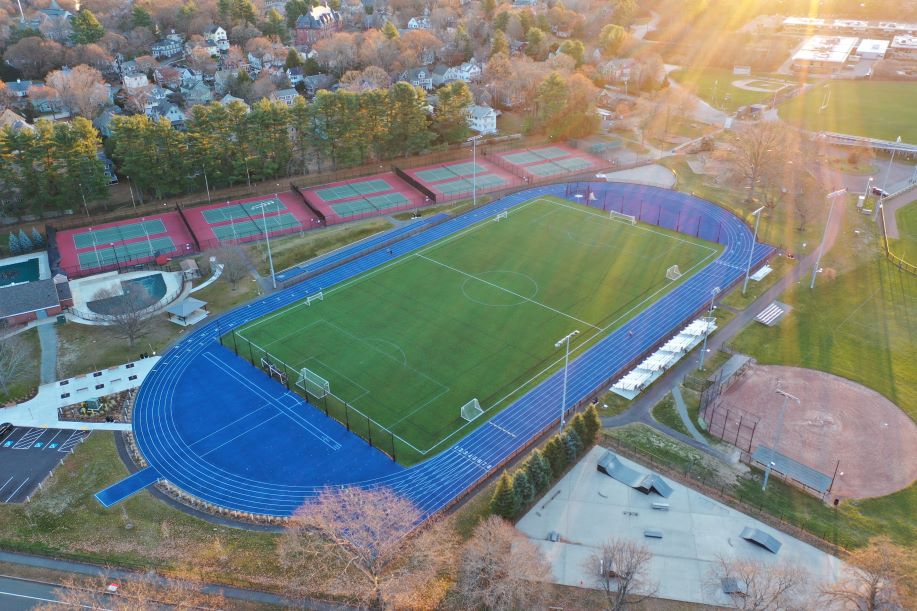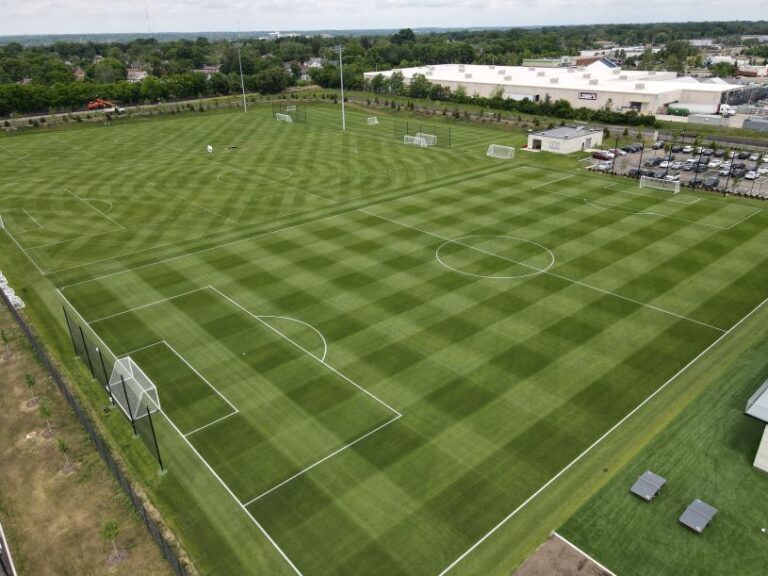By Mary Helen Sprecher
It is easy to look at a flat field and believe it is safe. Unfortunately, it is not until accidents, injuries and emergencies occur that problems become glaringly evident. That is why it is essential to do a safety audit on your facility on a regular basis, and to remain vigilant.
Safety audits can be performed by you or by your staff. Over time, it may be helpful to create a checklist or other document that is specific to your facility, noting areas that have been examined and problems that have been noted. Get started by using this article, by enlarging upon it and personalizing its points to fit your needs.
An essential part of your contacts when it comes to your safety audit is your specialty sports contractor, the person who built your field and/or your running track. By maintaining an open dialogue with these professionals, it will be possible to correct problems before they become accidents or injuries.
And sometimes, when it comes to fields, it’s the most easily overlooked things that can cause problems.
“Something essential is having the proper safety zones and/or runouts, defined as the areas outside the game lines of a particular sport,” said Paul Arcella of CSR Heavy & Athletic in Deerfield Beach, Fla. “Oftentimes, fences, bleachers or viewing areas are designed too close to the game lines of a sport, which can cause injuries when athletes run out of bounds and into fencing, videographers, photographers and spectators.”
It’s not just a youth-level problem. The NFL Players Association (NFLPA) recently voiced concern about the number of non-athlete personnel – including trainers, officials, media, cheer teams and others – on the sidelines of games, and noted that players running out of bounds have collided with all of these individuals.
The fence surrounding a sports facility should also be built so as to minimize the possibility of injury.
“I think one of the most glaring things we find is the fact that the perimeter fence has the fabric on the wrong side of the framework,” said Sam Fisher of Fisher Tracks in Boone, Iowa. “It is almost always hung with the fabric facing the spectators. It should be hung on the track side of the framework. There have been some very severe injuries where a hurdle has hit a fence post and come back at the athlete as well as the athlete that has tripped and tangled up with a fence post. The fabric being on the track side helps mitigate the potential severity of an injury.”
And that, said Arcella, is one of many reasons schools should work with an experienced sports contractor who understands what he calls, “the nuances of sports facility design and construction.”
Something else to consider, added Todd Smith, Ph.D., PE, LEED AP of R&R Engineers-Surveyors, Inc. in Denver, Colo., is the method of grooming baseball and softball fields.
“For the infields, the main mistake is not doing a little maintenance each day or each time the field is used. The second-most often made mistake, in my experience, is always dragging from the center in a spiral to the outside to avoid equipment tracks if they end in the center. This is the number-one cause of what is called the “infield lip,” which is when the infield mix is deposited into the first two to three feet of the outfield edge. This raises the rootzone and the grass grows through it. Then it gets raised again, the grass goes through it again.”
That lip not only creates a dam that impedes drainage, it can cause a ball that has hit the ground and begun to roll to spike back up. (If a player is chasing it, that flying ball can cause injury.)
Also in baseball and softball facilities, netting to contain batted balls is a concern; check with the governing body for the appropriate level of play your facility is hosting and make sure you are in compliance.

Facility walk-through
Start your audit by walking your field. This is going to be your chance to get up close and personal with the surface and to see any problems in the making.
John Schedler of Baraka Sport in Fort Worth, Texas, said that early inspections, done regularly, can keep minor problems from worsening. Nothing, he added, improves with inattention.
“I’ve seen many surfaces that were left without any repair, advice or attention for way too long. This typically accelerates the age, and early replacement is more likely. Repairs become more invasive, time consuming and costly if left unattended for too long.”
In order to improve your recordkeeping, bring these three things when doing your facility audit:
- Your phone or tablet to take pictures of any areas of concern (don’t turn the audit into screen time, though, or you stand to miss potential problems in the making).
- A notepad to write down any questions, concerns or problems (or you can use the note app of your phone or tablet for this purpose).
- Something easy to carry that will allow you to temporarily mark problem areas on the field or track until you can address them (or have them addressed by your builder). Some builders advise using small plastic cones or temporary flags that can be collected later.
As you travel the field, look for areas of concern; these might include sections where the field is skinned, worn, dry or rutted. Muddy areas or those with pooling water could indicate a problem with drainage that needs to be addressed.
“If you’re looking at tracks, keep an eye out for delamination, especially in high-wear or stress areas,” said Schedler. “If you’re walking across a synthetic field, look for visible seams, planarity issues, which will take the form of wavy lines. Other things to look for are slow drainage, contamination (dust, sand, dirt, organics usually from the surrounding landscape) loose fibers, weeds, grasses, discoloration and uneven infill levels.”
If checking a natural field, this is also a good time to check for signs of pests such as moles, voles, groundhogs or gophers whose tunnels or burrows could create instability in the soil, or worse, create a hole an athlete might step into in the midst of a game.
While you are on the field, check goals and/or field events that are there. Everything should be safe, secure and in good working order.
Fence and gate inspection
Check your fences; look for rails that might be loose, posts that lean or chain link fabric that is broken, bent or rusted and likely to cause an injury. If the tops of posts are padded (many baseball and softball fields have this feature to protect athletes who want to attempt challenging catches), ascertain that all padding is snug and unlikely to move when an athlete comes into contact with it. Check gates and make sure they swing cleanly and, if applicable, can be closed and locked when the facility is not in use.
Check-up of accessories and amenities
Bleachers, whether folding, portable or stationary, should be solid and safe. Check seats and steps, as well as handrails, and make sure nothing is loose. If there are dugouts or team seating areas, examine those as well. Lighting systems should be working, not just on the field but in any pedestrian areas.
Safety is a process, not an event
The safety audit is an essential tool when it comes to identifying problems in the facility and correcting them before they result in injuries; however, it does not take the place of ongoing awareness. Sports surfaces and equipment should be evaluated throughout the competition since conditions can change quickly, depending upon the weather, the sport and the level of play.
Mary Helen Sprecher wrote this article on behalf of the American Sports Builders Association (ASBA), the national organization for builders, design professionals and suppliers of materials for sports fields, running tracks, tennis courts and indoor and outdoor courts and recreational facilities.
Full information on athletic facility design and construction, as well as other resources, can be accessed by contacting the ASBA. Two publications, Sports Fields: A Construction and Maintenance Manual, and Running Tracks: A Construction and Maintenance Manual, may be of use in designing and building facilities that can, when maintained correctly, provide years of safe enjoyment. Moe information is available at www.sportsbuilders.org.


